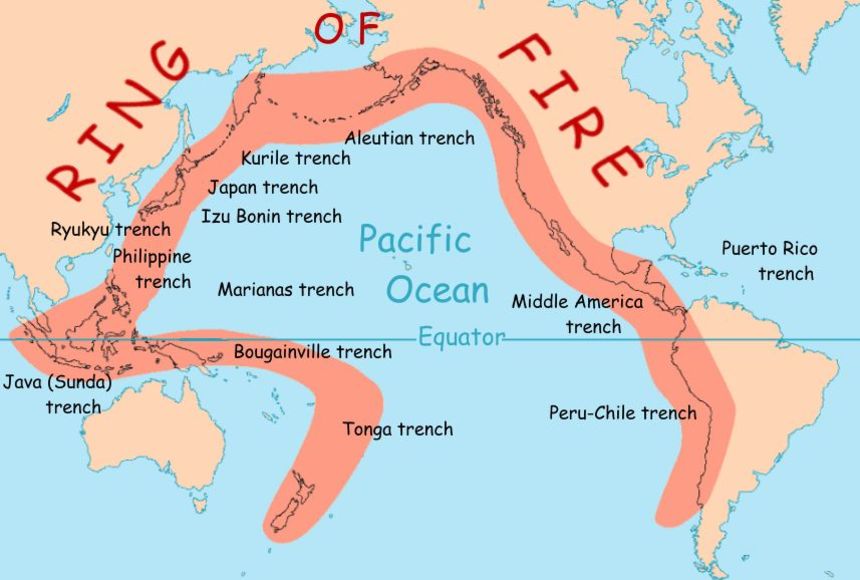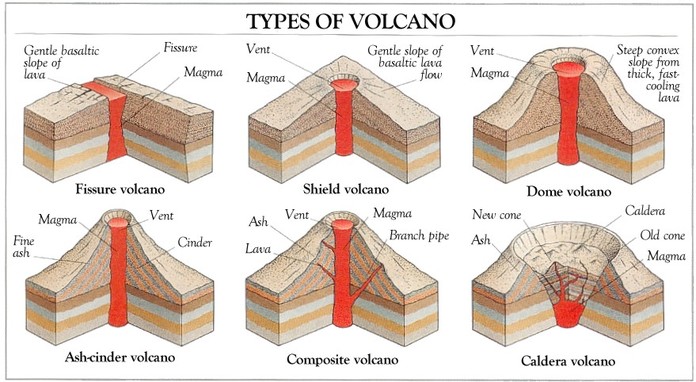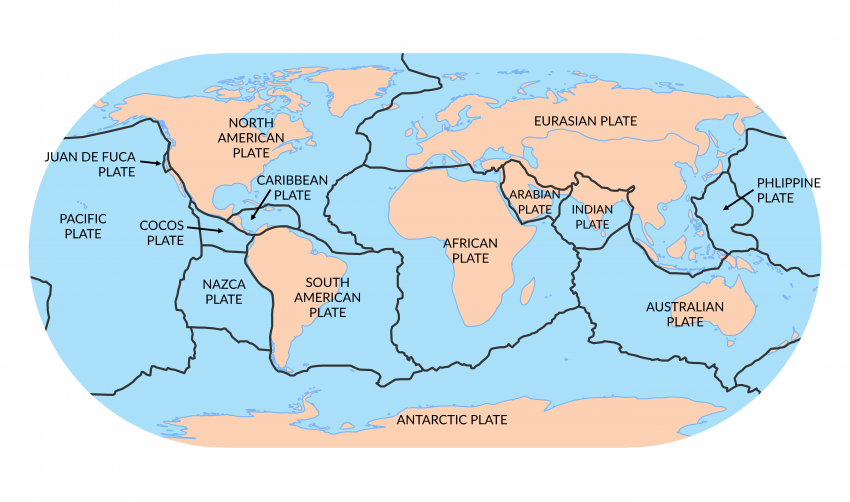VOLCANOES
The Marapi volcano, located in West Sumatra, Indonesia, is part of the Pacific Ring of Fire. The Ring of Fire is a horseshoe-shaped area in the Pacific Ocean basin where a large number of earthquakes and volcanic eruptions occur. It's characterized by active tectonic plate boundaries, including subduction zones, where one tectonic plate is forced beneath another.
Marapi is one of Indonesia's most active volcanoes and stands about 2,891 meters (9,485 feet) tall. It's situated near the city of Bukittinggi and has a history of frequent eruptions. While some of its eruptions have been relatively small and non-explosive, it has occasionally produced more significant eruptions with ash plumes and pyroclastic flows.
The region surrounding Marapi and much of Indonesia, in general, is part of the Pacific Ring of Fire due to the complex tectonic activity in the area. The Indo-Australian Plate is subducting beneath the Eurasian Plate, leading to seismic and volcanic activity along the Sumatran Fault and other associated fault lines.
The Pacific Ring of Fire is known for its high seismic and volcanic activity, housing a majority of the world's active volcanoes and experiencing a large number of earthquakes. This area's geological dynamics make it prone to geological hazards, but it also provides valuable insights into plate tectonics and volcanic activity for scientific research

3. Volcanoes and Volcanic Landforms
Volcanoes are natural features on Earth's surface that form when magma (molten rock beneath the Earth's crust) erupts through openings or vents. The erupted materials, including lava, ash, gases, and pyroclastic flows, accumulate around the vent, building up and forming various volcanic landforms. Here are some key volcanic landforms:
Shield Volcanoes: These are broad, gently sloping volcanoes characterized by their low viscosity lava, which flows easily. They're built up by numerous eruptions of thin, runny lava. Examples include Mauna Loa in Hawaii and the Galápagos Islands' volcanoes.
Stratovolcanoes (Composite Volcanoes): These are steep-sided, conical volcanoes built by multiple layers of lava, ash, and volcanic rocks. They are often associated with explosive eruptions due to their viscous lava. Famous examples include Mount St. Helens in the United States, Mount Fuji in Japan, and Mount Vesuvius in Italy.
Cinder Cone Volcanoes: These are small, steep-sided volcanoes formed from ejected lava fragments that pile up around the vent. They usually have a bowl-shaped crater at the summit. Paricutin in Mexico is a well-known cinder cone volcano.
Calderas: These are large, basin-shaped depressions formed after massive eruptions, where the volcano's summit collapses into the emptied magma chamber. Crater Lake in Oregon, USA, is a prime example of a caldera.
Lava Plateaus: These are vast flat areas created by successive lava flows that cover large areas of land. The Deccan Plateau in India and the Columbia River Plateau in the United States are examples of lava plateaus.
Volcanic Islands: Many islands around the world, like Hawaii, Japan, and the Philippines, were formed by volcanic activity. These islands were created as volcanoes erupted underwater and gradually built up above sea level.
Volcanic Craters: Formed at the summit of some volcanoes, these bowl-shaped depressions are created either by explosions or the collapse of the volcano's summit following an eruption.
Volcanic landforms vary based on factors like the type of eruption, the composition of the lava, and the frequency of eruptions. They contribute significantly to the Earth's landscape and often provide fertile soils and valuable resources, while also posing risks to nearby populations due to potential eruptions and associated hazards
4. Types of Volcanoes

Volcanoes come in various types, each formed by different eruptive processes and materials. Here are the main types of volcanoes:
Shield Volcanoes: These volcanoes have broad, gentle slopes due to the relatively fluid lava (low viscosity) they produce. Eruptions from shield volcanoes tend to be non-explosive and result in the flowing of lava over large distances. Examples include Mauna Loa and Mauna Kea in Hawaii.
Stratovolcanoes (Composite Volcanoes): Stratovolcanoes are tall, steep-sided cones formed by alternating layers of lava, ash, and volcanic rocks. They often produce explosive eruptions due to the higher viscosity of their lava. Mount St. Helens in the United States and Mount Fuji in Japan are examples of stratovolcanoes.
Cinder Cone Volcanoes: These small, steep-sided volcanoes are formed from the accumulation of pyroclastic material (such as ash, cinders, and volcanic rocks) ejected during eruptions. They usually have a bowl-shaped crater at the summit. Paricutin in Mexico is a famous cinder cone volcano.
Lava Domes: Lava domes are created by the slow extrusion of highly viscous lava. They form rounded mounds often found within the craters of larger volcanoes. Lava domes, such as Mount St. Helens' post-eruption dome, can be highly unstable and prone to collapse.
Complex Volcanoes: These are composite volcanoes that exhibit multiple vents and overlapping cones. They're formed by the accumulation of materials from various eruptions over time. Mount Rainier in the United States is an example of a complex volcano.
Submarine Volcanoes: Found underwater, these volcanoes create seamounts or volcanic islands. They can form chains, like the Hawaiian-Emperor seamount chain, as tectonic plates move over hotspots beneath the Earth's crust.
Supervolcanoes: These are rare but extremely powerful volcanoes capable of producing colossal eruptions. They form immense calderas after catastrophic explosions that empty the magma chamber. Yellowstone Caldera in the United States is an example of a supervolcano
5. Relation among Plate Tectonics, Volcanoes and Earthquake
Plate tectonics, volcanoes, and earthquakes are interconnected and are all part of the Earth's dynamic processes.

Plate Tectonics: The Earth's lithosphere (the outermost layer) is divided into several large and small plates that float on the semi-fluid asthenosphere beneath them. These plates are in constant motion, driven by forces like mantle convection, and this movement is known as plate tectonics.
Volcanoes: Volcanoes are closely associated with plate boundaries, where tectonic plates interact. There are three primary types of plate boundaries:
-
-
Divergent Boundaries: At divergent boundaries, plates move away from each other. Magma from the mantle rises to fill the gap, solidifies, and creates new crust. This process forms mid-ocean ridges, where underwater volcanoes and volcanic activity occur.
-
Convergent Boundaries: At convergent boundaries, plates move toward each other. When an oceanic plate collides with a continental plate or another oceanic plate, the denser oceanic plate sinks beneath the lighter plate in a process called subduction. The sinking plate melts as it descends into the mantle, leading to the formation of magma that rises to the surface, resulting in explosive volcanoes. Examples include the Andes and the Cascades.
-
Transform Boundaries: At transform boundaries, plates slide past each other horizontally. While these boundaries are not associated with volcanic activity directly, the stress buildup and release along these boundaries often cause earthquakes.
-
Thus, the movement and interaction of tectonic plates at plate boundaries create conditions conducive to both volcanic eruptions and seismic activity (earthquakes). The locations and types of volcanoes and earthquakes are influenced by the specific plate boundary and the nature of the plate movement at that boundary. Overall, plate tectonics serve as the underlying mechanism that connects the occurrence of volcanoes and earthquakes on Earth
6. How can volcanic eruptions affect the environment and natural ecosystem?
Volcanic eruptions can have significant impacts on the environment and natural ecosystems in several ways:
Air Quality: Eruptions release gases such as sulfur dioxide, carbon dioxide, hydrogen sulfide, and others. These gases can contribute to air pollution, leading to acid rain formation, smog, and the potential for respiratory issues in humans and animals.
Climate Effects: Volcanic ash and gases can reach the upper atmosphere, where sulfur dioxide reacts with water vapor to form sulfuric acid aerosols. These aerosols can reflect sunlight, leading to a cooling effect on the Earth's surface. However, this effect is temporary and can be followed by a period of warming due to greenhouse gases emitted during the eruption.
Ash Fallout: Volcanic ash can blanket large areas, affecting vegetation by blocking sunlight, damaging crops, and contaminating water sources. Heavy ashfall can collapse roofs, disrupt transportation, and damage infrastructure.
Lahars and Mudflows: Eruptions can melt snow and ice on a volcano's slopes, generating lahars (volcanic mudflows) that carry debris, ash, and rocks downslope, potentially devastating nearby communities and ecosystems.
Ecosystem Disturbance: Volcanic eruptions can destroy habitats, vegetation, and animal populations. However, some ecosystems are adapted to volcanic activity and may even benefit from the nutrient-rich volcanic soils that support new growth over time.
Water Contamination: Ash and volcanic materials can contaminate water sources, affecting aquatic life and making water unsafe for consumption.
Global Effects: Major volcanic eruptions, especially so-called "supervolcano" eruptions, can release vast amounts of ash and gases into the atmosphere, potentially leading to short-term global climate effects, including temperature drops and altered weather patterns
|
For Prelims: Indian and World Geography-Physical, Social, Economic Geography of India and the World
For Mains: General Studies I: Important Geophysical phenomena such as earthquakes, Tsunami, Volcanic activity, cyclone etc., geographical features and their location-changes in critical geographical features and in flora and fauna and the effects of such changes
|




